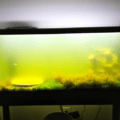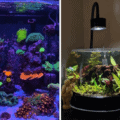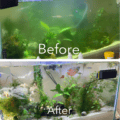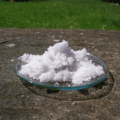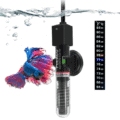In this insightful guide we dive into the phenomenon of bubbles in aquariums, exploring their various causes and effects. While some bubbles may be benign, others could signal underlying issues in water quality or fish health. From protein film formation to plant pearling and fish breeding behaviors, we dissect the seven common causes of bubbles in fish tanks.

I noticed some foam on its surface, and I couldn’t tell why there are tiny bubbles in my fish tank.
I wondered whether they could be an indication of something bad happening in the water column and if it can harm my aquatic pets.
The little air bubbles would sometimes appear on the aquarium glass after a water change, but they would usually dissipate in a short while.
This time they remained at the top, forming some sort of shiny foam that I later discovered was protein film. Luckily, I researched and found out what causes microbubbles to appear in aquariums and how to get rid of them.
In this post, I’ll share my knowledge and experience to help you out.
Are Bubbles in the Aquarium Good or Bad?
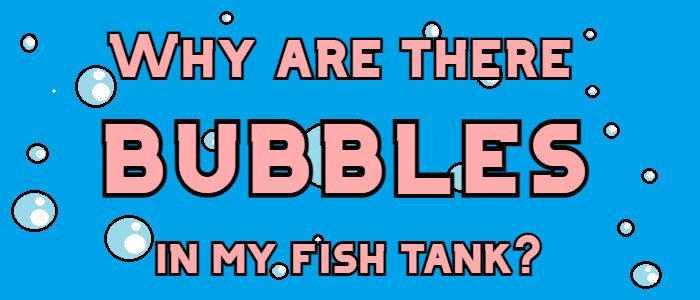
Actually, in fish tanks, bubbles form for many reasons and most of them aren’t cause for concern.
A few common yet benign ones are:
- Bubbles often appear on the surface of the aquarium because of agitation created by your airstone or HOB filter. In this scenario, they will pop quickly after rising to the top
- Air bubbles can also form on the aquarium glass after a water change, which is natural. This happens if you’ve added colder temperature water. This effect is due to the ability of the cold water to hold more dissolved oxygen. As the water temperature rises, the oxygen gets released, which creates tiny bubbles in your fish tank.
There are even more reasons you may be witnessing this aquarium phenomenon without it being a sign that something’s wrong.
I will explain them in detail below.
With that being said, in some cases, the bubbles may form surface foam on top of your fish tank.
This may indicate that you need to take a closer look at the water quality.
Here’s when bubbles that appear in your fish tank can signal a bad thing:
If there are foamy bubbles covering the surface of your aquarium water and they’re not popping, then they’re likely caused by organic waste in the water column. The protein from decaying fish feces, and uneaten food attaches to the tiny air bubbles and creates a protein film around them.
This foam can sometimes smell foul.
7 Causes for Bubbles in Your Fish Tank?
In the following sections I’ll thoroughly go over:
- the different causes of bubbles appearing in your fish tank
- what they indicate
- how to get rid of the bubbles
1. Protein and oils from organic waste in the water column

Decaying organic matter in an aquarium is typically the byproduct of:
- fish waste
- food leftovers
- dead plants
- A fish or other animal that has recently died inside the tank
- other debris
Decaying matter releases some proteins and other oils that attach themselves to the surface of the air bubbles in your aquarium water, creating a stable film that traps the oxygen. The result is a somewhat slimy foam forming on top of the aquarium.
This occurrence is more prevalent in saltwater tanks, but can also appear in freshwater fish tanks.
You can get rid of the bubble foam by increasing the water surface’s agitation or collecting the proteins and oils via a device called a protein skimmer.
Creating “agitation” basically means making the top of the water move more. This can be done by a HOB or sponge filters. Bubbly foams form easily in new tanks without filters, which is not good for the fish inside at all.
If you have a saltwater aquarium, you could use a dedicated protein skimmer to remove the proteins and oils from the water column, which eventually gather on top of the tank.
Nevertheless, your first course of action if there are protein foam in your fish tank, should be to use your water test kit to measure the ammonia and nitrite levels.
If the microbubbles on the surface don’t dissipate and the foam remains, this may be a sign that there aren’t enough beneficial bacteria to handle the accumulated organic waste.
If your water test shows that the ammonia and nitrite readings are ABOVE 0 ppm (parts per million), you should take measures to lower them.
Changing water can bring the toxic ammonia in an aquarium down to the desired levels and help you get rid of the microbubbles for good. The same method can be used to lower Nitrite levels, but if that doesn’t help visit the links to learn about other ways to do so.
Oily protein foam often forms in new fish tanks where the Nitrogen cycle is not complete. This is also typically in tiny fishbowls since waste can build way more quickly in smaller aquariums.
2. Release of saturated oxygen after a water change

Sometimes you may see tiny air bubbles on the aquarium decorations or the glass walls of your fish tank after a water change.
This is likely due to the temperature difference between the new water and the aquarium’s water.
This often occurs if you don’t pre-heat the water, matching its temperature to that of your fish tank. The colder water can trap more dissolved oxygen than warm water.
Once the new water’s temperature rises after adding it to the fish tank, the oxygen gets released, creating microbubbles.
Most of the time you shouldn’t get concerned over this, as it’s totally natural.
Pouring cold water in your aquarium is not recommended but the little bubbles themselves will go away in a short while.
To make them pop faster, you can increase the agitation, which will push them to the top of the aquarium and make them dissipate.
Author’s note: In some instances the quick gas release could be dangerous to your aquatic pets. This happens if you’re performing a larger water change without taking precautions.
The more intense gas release could cause a formation of bubbles in your fish’s eyes, blood, and fins. This is known as Gas Bubble Trauma, which is sometimes the reason why fish die or get stressed after a water change.
Therefore, I recommend always making sure everything is in check if you’re changing more than 30% of the aquarium’s water.
Another way to protect your fish from the potentially harmful bubbles is to stir the water before adding it to their tank.
Stirring will increase gas exchange and prevent bad consequences.
3. Contamination with chemicals from detergents
Chemicals from cleaning detergents may find their way into the aquarium water by accident.
The result is foamy bubbles on the top of the tank.
One scenario is your tank not having a lid and you using aerosol disinfectants or detergents near it.
Some of the products may enter the aquarium water and create a shiny foam layer with a rainbow tint. The same can happen if during regular aquarium maintenance you use cleaning tools that have already been used for other cleaning purposes.
If you have doubts that cleaning detergents are behind the formation of the little bubbles in your fish tank, you should immediately perform a water change.
4. Male betta fish making a bubble nest

Some fish species, such as bettas and gouramis, build bubble nests as part of their breeding ritual. The fish blows tiny air bubbles covered in special saliva which then form a mat on the water’s surface and do not pop easily.
This behavior is completely natural and signifies that your pet fish is ready to mate.
Male bettas would usually construct their nests around or underneath plant leaves near the top of the tank. This is because tall or floating plants give Betta fish a feeling of safety.
Even though bubble nests are made by male specimens, you may also see tiny bubbles in tanks with female betta fish. That’s because all Siamese fighting fish have what’s called “labyrinth” lungs.
This type of lung lets them breathe oxygen directly from the surface of the fish tank.
The gulp of air that the Betta takes at the top of the tank may cause little oxygen bubbles to form there, which is not a bad thing.
5. Plant pearling
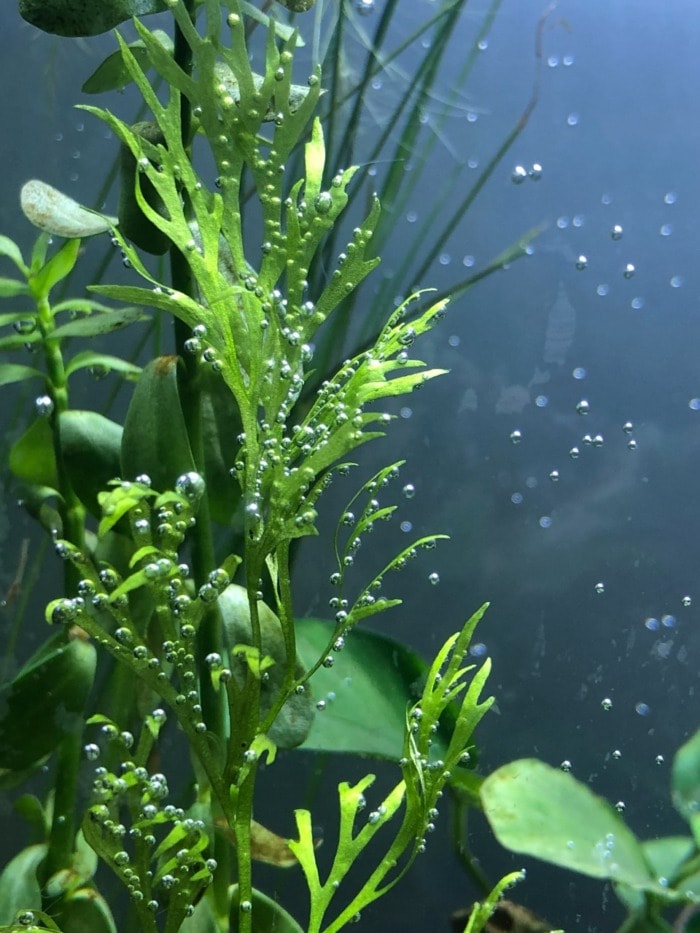
If you’re keeping aquatic plants in your fish tank, you may notice that white bubbles are forming on the surface of their leaves.
This is a completely natural process, known as plant pearling.
It’s a result of photosynthesis and is due to oxygen release. Since the water in the tank isn’t capable of holding all the oxygen produced within it, tiny bubbles would start appearing on your plants and floating to the water surface.
This isn’t a cause for concern and won’t harm your aquatic inhabitants.
Quite the opposite – it indicates that your plants are thriving and there’s a lot of saturated oxygen around them.
6. Too Much Water Agitation
Microbubbles are often formed by too much water agitation and sometimes to the point where the water looks cloudy. Agitation following a cleaning or other aquarium maintenance is one scenario.
On the other hand, the bubbles could also appear near a powerful canister filter, or as a result of a working airstone. In these cases, a newly-formed bubble would rise to the top of the tank and quickly dissipate in the air.
With that being said, setting your air pump or aquarium filter to work at their maximum capacity may create too much unnecessary water agitation. Even though aeration is beneficial to a fish tank, it doesn’t need too much of it.
Conversely, not enough movement in the water can lead to stagnant areas on the sides of the aquarium where the tiny bubbles could get “stuck”.
In other words, when it comes to setting your filters and aeration units, moderation is key.
7. Fish Medications
If you’ve recently treated a sick fish with some sort of medication it could be that the medication is the culprit behind the bubbles.
Some fish medications and chemicals can temporarily change the chemical composition of the water in the tank, causing bubbles to form foam on the surface.
If this is the case, and the treatment is finished you can use a carbon filter to remove the chemicals from the water.
Most bubbles caused by fish medications will disappear soon after the treatment, but a carbon filter guarantees success in these situations.
My Closing Thoughts
You can’t expect an aquarium to not have a few bubbles here and there but too much of anything can become a problem. Protein and oily foams are often an issue in fish tanks that have not established balanced water parameters.
I hope that you’ve found my article useful and that you got the answers you were looking for.
If further questions arise, feel free to leave them as a comment in the section below.





